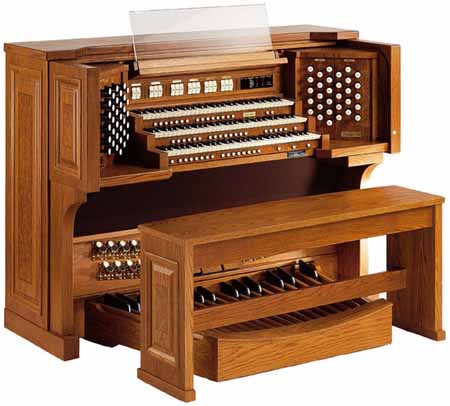FUTURE STYLE
 With Prestige Organs, the musician can perform different kinds of music, from baroque to romantic, with the touch of a finger. All parameters can be easily changed and adapted without the need of substituting the registers like in traditional digital organs. Each Organ has its own personality and possesses almost human qualities. Technical Specifications Manuals: 3 x 61 keys tracker touch keyboard with dynamic control for MIDI and Orchestra sections Pedalboard: 32 Notes Straight or Straight concave or Radiating concave Stops: 57 drawstops Voice controls: Volume- Attack time -Release detune -Tracking keyboard volume -Ensemble (Pipes detune simulation)-Possibility of sending the voices on 8 different Main Out and 4 different Anthiponal Out outputs (simulation of a windchest "somiere") Orchestra voices: See list on organ description pages. Any voice of each section may be replaced by any other voice of the standard general mid Orchestra voices Controls: Volume - Brightness - Octave transposer - Keyboard range adjustment Poliphony: 512 Notes for the Classical voices 40 Notes for the Orchestra voices General memories: 10*8 banks programmable + HR Divisional memories: 6 programmable + HR for each section (Man. I-II-III and -Ped) * 8 banks Tutti: Programmable Crescendo: 16 programmable steps Couplers: Man.I / Pedal - Man.II / Pedal - Man.III / Pedal - Man.III / Man.II - Man.III / Man.I - Man.I / Man.II Memory Banks: 8 Divisional controls: 56 thumb pistons for general and divisional memories, Memory - and +, Set, Cancel, Couplers, Automatic Pedal, Tutti, Enclosed, Organ Solo and Midi Solo Volume controls: General, Man.I, Man.II, Man.III, Pedal, Orchestra, Reverb Toe pistons: 21 for Couplers, General memories, Memory - and +, Tutti , Midi Reverse, Midi & Orchestra Sustain Pedals: Expression pedals for Man. I and Man. III with Led control on central panel, Crescendo with Led display on central panel Cancels: Mixture and Reed emperamentsManual Reverse: Man. II - Man. I Memo couplers: Man. II with Pedal Temperaments: Equal, Meantone, Chaumont, Werckmeister, Kirnberger, Pythagorean, Vallotti, Kellner Transposer: '-6 / +5 half tones Reverb: 8 different types of Digital Reverb - Optional Yamaha AFC Reverb. (Active Field Control) Equalizer: 5 bands (digital) for the internal amplification and for each external output Outputs: 8 Main Output and 4 Antiphonal Out Jacks - 2 RCA (L/MONO - R) Outputs Inputs: 2 Programmable Jack inputs - 1 Jack microphonic Input with gain control - 2 RCA (L/MONO -R) inputs Midi: In - Out - Thru Midi Controls: 2 selectable output and input channels for each section, Program Change, Adjustment of the key dynamic - transposer, filter Floppy Disk Driver: 3,5" DD (720 Kb) e HD (1,44 Mb), MS-DOS formatted Floppy File controls: Read, format, copy, save (settings and memories), load of settings and memories, cancel, rename and file check Sequencer: With 5 indipendent tracks, till 60000 events, 1292 t.p.q.n. resolution, save on disk as Standard Midi File Format 1 Remote Control (optional): For the reproduction of the recorded sequences - control for the general volume of the organ Internal amplification: 5 amplifiers for a total of 400 W - 7 amplifiers for a total of 460W in the model with AFC Reverb. Delay time for each manual Loudspeakers: 1 Woofer 12", 4 middle-range 4", 4 horn-tweeter. (In the model with AFC Reverb: 1 Woofer 12", 4 middle-range 4", 4 horn-tweeter, 2 full-range) Cabinet & accessories: Wood veneered matt polished in dark, light or medium oak with brier wood frames. Lighted music rest, locking roll cover and matching bench HxWxDxD w. pedalb. 132x176x78x115 cm
|
|
|
advanced technologic sound magazine 2005 July issue 139
|
